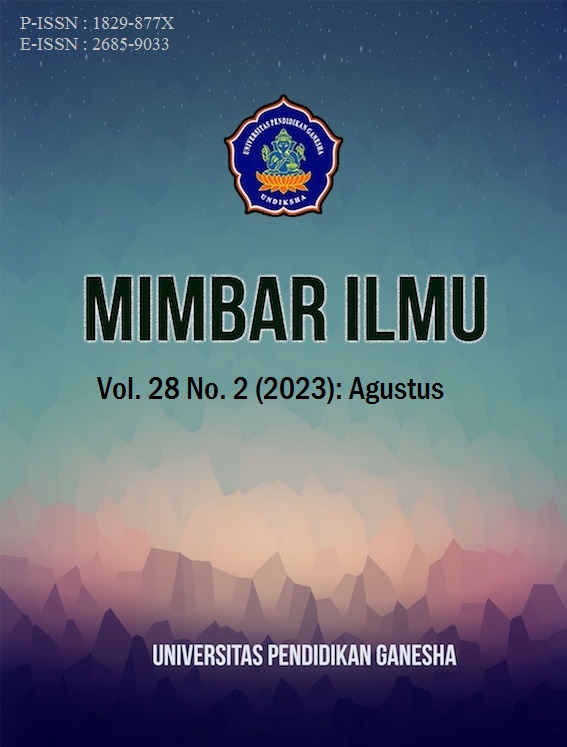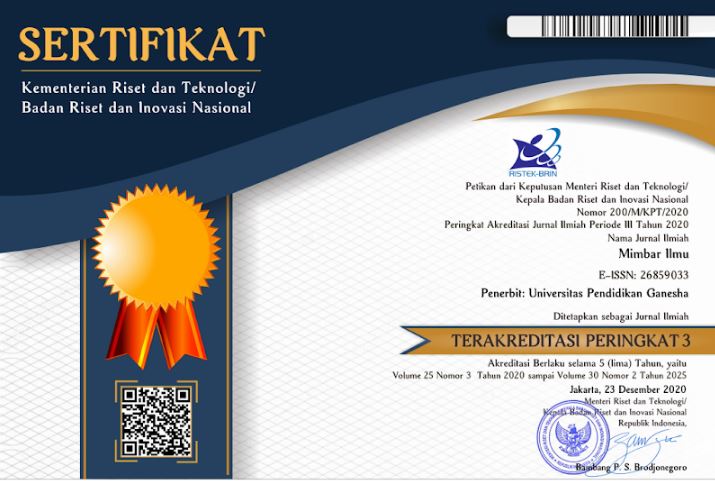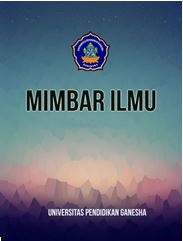Grammatical Features in Indonesia English: A Study of Indonesian College Students
DOI:
https://doi.org/10.23887/mi.v28i2.53866Keywords:
Grammatical features, College students, Indonesian EnglishAbstract
This study aims to expose detailed descriptions of the grammatical features of Indonesian English. Indonesian English refers to a newly recognised linguistic variety of English as proposed by Coleman (2017). The grammatical characteristics as the result of acquiring a new language lead to the presence of a new variety of Indonesian English. Applying descriptive qualitative research, the data were collected based on recordings of the speech of 24 college students on three different topics. Following the principle proposed by Cogo and Dewey (2012), this study reveals twelve grammatical features as the characteristics of Indonesian English. They are namely the over-generalisation and omission of the copula BE (i.e am, is, are), the use of Indonesian collocation and literal translation, subject–verb agreement, the omission of the plural marker 's', assigning different lexical meanings, inappropriate prepositions, the omission of possessive markers, the omission and addition of articles, the application of verb tenses, the use of Indonesian acronyms and abbreviations, the incorrect construction of passive forms, and the use of Indonesian lexical items. It is shown that one of the main factors in the emergence of this new English variant is the contact of the multiple languages used by the speakers.
References
Abtahian, M., Cohn, A., & Pepinsky, T. (2016). Modeling social factors in language shift. International Journal of the Sociology of Language, 139–170. DOI: https://doi.org/10.1515/ijsl-2016-0036
Adnyani, N., Beratha, N., Pastika, I., & Suparwa, I. (2018). The development of verbal morphology and word order in an Indonesian-German bilingual child: A case study. Topics in Linguistics, 19(1), 33–53. https://doi.org/10.2478/topling-2018-0003. DOI: https://doi.org/10.2478/topling-2018-0003
Ahmadi, D. M. R. (2018). The Use of Technology in English Language Learning: A Literature Review. International Journal of Research in English Education, 3(2), 115–125. https://doi.org/10.29252/ijree.3.2.115. DOI: https://doi.org/10.29252/ijree.3.2.115
Aini, N., Mufid, M., & Sari, E. (2020). An analysis on interlanguage fossilization in students’ writing performance. IJOTL-TL, 5(1), 15–28. https://doi.org/10.30957/ijoltl.v5i1.612. DOI: https://doi.org/10.30957/ijoltl.v5i1.612
Apriliani, A. I., & Listyani, L. (2021). Students’ Perceptions of English Fun Fair as an Implementation of Project-Based Learning in Speaking for Social Purposes Classes. Celt: A Journal of Culture, English Language Teaching & Literature, 20(1). https://doi.org/10.24167/celt.v20i1.2677. DOI: https://doi.org/10.24167/celt.v20i1.2677
Aziez, F. (2016). An analysis of interlanguage performed by students of an Islamic boarding school in Tasikmalaya. ELT Perspective, 4(2), 102–122. DOI: https://doi.org/10.33603/perspective.v4i2.1543
Bahar, H., D., & Aprianto, E. (2019). The Indonesian syntactic structure interfere into English sentences : An interlanguage study. Budapest International Research and Critics in Linguistics and Education (BirLE) Journal, 2(4), 106–110. https://doi.org/10.33258/birle.v2i4.496. DOI: https://doi.org/10.33258/birle.v2i4.496
Bonafix, S., & Manara, C. (2016). Maybe English first and then Balinese and Bahasa Indonesia: A case of language shift, attrition, and preference. Indonesian Journal of English Language Teaching, 11(1), 81–99. https://doi.org/10.25170/ijelt.v11i1.837. DOI: https://doi.org/10.25170/ijelt.v11i1.1491
Boonraksa, T., & Naisena, S. (2022). A Study on English Collocation Errors of Thai EFL Students. English language teaching, 15(1), 164–177. https://doi.org/10.5539/elt.v15n1p164. DOI: https://doi.org/10.5539/elt.v15n1p164
Bui, T. L. (2021). The role of collocations in the english teaching and learning. International Jourrnal of TESOL & Education, 1(2), 99–109.
Burhansyah. (2019). Analysis of error sources in L2 written English by Indonesian undergraduate students. Studies in English Language and Education, 6(1), 71–83. https://doi.org/10.24815/siele.v6i1.6659. DOI: https://doi.org/10.24815/siele.v6i1.6659
Cogo, A., & Dewey, M. (2012). Analysing English as a lingua franca: A corpus-driven investigation. Bloomsbury Publishing.
Cohn, A., & Ravindranath, M. (2014). Local languges in Indonesia: Language maintenance or language shift? Linguistik, 32(2), 131–148. DOI: https://doi.org/10.26499/li.v32i2.22
Coleman, H. (2017). Bahasa Inggris Versi Indonesia (BIVI): Suatu gejala perubahan dalam kebudayaan Indonesia (Indonesian English Version: A symptom of change in Indonesian culture. In Pertemuan Ilmiah Bahasa dan Sastra Indonesia (PIBSI (bl 39). Universitas Diponegoro.
Dewi, A. (2014). Perception of English: A study of staff and students at universities in Yogyakarta, Indonesia. Cambridge Scholars Publishing.
Fauziati, E. (2011). Interlanguage and error fossilization: a study of Indonesian students learning English as a foreign language. Indonesian Journal of Applied Linguistics, 1(1), 25–40. https://doi.org/10.17509/ijal.v1i1.97. DOI: https://doi.org/10.17509/ijal.v1i1.97
Fauziati, E. (2017). Native and target language influence on the students’ interlanguage production: A case of Indonesian EFL composition. Indonesian Journal of Applied, 7(1), 54–63. https://doi.org/10.17509/ijal.v7i1.6858. DOI: https://doi.org/10.17509/ijal.v7i1.6858
Fauziati, E., & Maftuhin, M. (2016). Interlanguage verb tense systems of Indonesian EFL learners. Journal of Foreign Languages, Cultures and Civilizations, 4(2), 72–82. https://doi.org/10.15640/jflcc.v4n2a7. DOI: https://doi.org/10.15640/jflcc.v4n2a7
Fauziati, E., & Nugroho, A. (2019). Cognitive Processes Featuring Learner Language: A Study of Indonesian Students Learning English as a Foreign Language. ICoLLiT (International Conference on Language, Literature and Teaching, 208–214.
Gayo, H., & Widodo, P. (2018). An analysis of morphological and syntactical errors on the English writing of junior high school Indonesian students. International Journal of Learning, Teaching and Educational Research, 17(4), 58–70. https://doi.org/10.26803/ijlter.17.4.4. DOI: https://doi.org/10.26803/ijlter.17.4.4
Greenbaum, S., & Nelson, G. (2016). An introduction to English grammar (4th ed). Routledge.
Gumilar, D., Sudana, D., & Syaifullah, A. (2018). Interlanguage grammar in English:Produced by Indonesian students learning French. Advances in Social Science, Education and Humanities Research, 257, 402–405. https://doi.org/10.2991/icollite-18.2019.89. DOI: https://doi.org/10.2991/icollite-18.2019.89
Hamied, F. (2012). English in multicultural and multilingual Indonesian education (A. Kirkpatrick & R. Sussex (reds)). Springer. https://doi.org/10.1007/978-94-007-4578-0_5. DOI: https://doi.org/10.1007/978-94-007-4578-0_5
Hamied, F. (2013). ELT intricacies within the Indonesian language policy. In T. Bigalke & S. Sharbawi (Reds), English for ASEAN Integration: Policies and practices in the region (bll 32–40). IELTS.
Harta, I. G. W., Bay, I. W., & Ali, S. W. (2021). An analysis of lexical collocation errors in students’ writing. TRANS-KATA: Journal of Language, Literature, Culture and Education, 2(1), 15–25. https://doi.org/10.54923/transkata.v2i1.18. DOI: https://doi.org/10.54923/transkata.v2i1.18
Hidayati, I. (2012). Evaluating the role of L1 in teaching receptive skills and grammar in EFL classes. Indonesian Journal of Applied Linguistic, 1(2), 17–32. https://doi.org/10.17509/ijal.v1i2.82. DOI: https://doi.org/10.17509/ijal.v1i2.82
Iman, T. R. (2020). The Interference of Indonesian Language on English. Journal of Languages and Language Teaching (JOLLT ), 8(2), 170–182. https://doi.org/10.33394/jollt.v8i2.2466. DOI: https://doi.org/10.33394/jollt.v8i2.2466
Kasmini, M. (2015). An Analysis of Using Bahasa Indonesia In EFL Classroom Activities: A Qualitative Study At SMP Negeri 8 Kota Cirebon.
Kusumawardani, D., & Adnyani, N. (2020). Interlanguage Analysis on Speech Produced by EFL. Retorika: Jurnal Ilmu, 6(2), 178–185. https://doi.org/10.22225/jr.6.2.1727.178-185. DOI: https://doi.org/10.22225/jr.6.2.1727.178-185
Leech, G., Conrad, S., & Biber, D. (2002). Student grammar of spoken and written English. Longman.
Maheswari, P., Adnyani, N., & Suwastini, N. (2020). Interlanguage analysis on Indonesian EFL learners’. Lingua Didaktika, 14(2), 121–131. https://doi.org/10.24036/ld.v14i2.108643. DOI: https://doi.org/10.24036/ld.v14i2.108643
Mandarani, V. (2020). Grammatical error of EFL senior high school learners in writing: A review of language interference studies. Teaching of English Language and Literature, 8(1), 1–6. https://doi.org/10.30651/tell.v8i1.4158. DOI: https://doi.org/10.30651/tell.v8i1.4158
Mattarima, K., & Hamdan, A. (2011). The teaching constraints of English as a foreign language in Indonesia: The context of school based curriculum. Sosiohumanika, 4(2), 287–300. https://doi.org/10.2121/sosiohumanika.v4i2.452.
Nofrika, I. (2019). EFL Students’ Voices: The Role of YouTube in Developing English Competences. Journal of Foreign Languange Teaching and Learning, 4(1). https://doi.org/10.18196/ftl.4138. DOI: https://doi.org/10.18196/ftl.4138
Paramita, G. A. P. P., Gede Agung, A. A., & Abadi, I. B. G. S. (2022). Buku Cerita Bergambar Guna Meningkatkan Keterampilan Membaca Muatan Pelajaran Bahasa Indonesia Siswa Kelas III SD. Mimbar Ilmu, 27(1), 11–19. https://doi.org/10.23887/mi.v27i1.45499. DOI: https://doi.org/10.23887/mi.v27i1.45499
Prasentianto, R. (2015). mperfect aspect in English and Indonesian verbs. Nusantara of Research, 2(1), 84–89.
Pratiwi, P., Adnyani, N., & Putra, I. (2020). Native and target language influence on students’ interlanguage speech. Linguistika, 27(2), 109–122. DOI: https://doi.org/10.24843/ling.2020.v27.i02.p02
Puspita, D. (2019). Error analysis on learners’ interlanguage and intralanguage: A case study of two adolescent students. TEKNOSASTIK, 17(2), 12–18. https://doi.org/10.33365/ts.v17i2.321. DOI: https://doi.org/10.33365/ts.v17i2.321
Rahman, Y. A. (2021). Collocation Errors in Indonesian EFL Learners’ Composition. Journal of English Language Learning, 5(2). https://doi.org/10.31949/jell.v5i2.3686.
Rahmayanti, P., Padmadewi, N. N., & Artini, L. P. (2020). Teachers’ Readiness in Inserting the 21st Century Skills in the Lesson Plan in Teaching English. Jurnal Pendidikan dan Pengajaran, 53(2), 168. https://doi.org/10.23887/jpp.v53i2.26406. DOI: https://doi.org/10.23887/jpp.v53i2.26406
Razak, N. A., Alakrash, H., & Sahboun, Y. (2018). English language teachers’ readiness for the application of technology towards fourth industrial revolution demands. Asia-Pacific Journal of Information Technology and Multimedia, 7(2). https://doi.org/10.17576/apjitm-2018-0702(02)-08. DOI: https://doi.org/10.17576/apjitm-2018-0702(02)-08
Sanguannam, S. (2017). A study on “Delexical Verb+Noun” collocation errors of Thai EFL intermediate and advanced learners. Journal of Liberal Arts, 17(2), 59–84.
Sari, E. (2016). Interlingual errors and intralingual errors found in narrative text written by EFL students in Lampung. Jurnal Penelitian Humaniora, 17(2), 87–95. https://doi.org/10.23917/humaniora.v17i2.2501. DOI: https://doi.org/10.23917/humaniora.v17i2.2501
Sari, P., Santosa, M., & Adnyani, N. (2020). Investigating junior high school students’ errors in using English past tense: A look from technological and sociological foundations. ETERNAL (English, Teaching, Learning, and Research Journal, 6(2), 245–258. https://doi.org/10.24252/Eternal.V62.2020.A5. DOI: https://doi.org/10.24252/Eternal.V62.2020.A5
Sert, N., & Boynueğri, E. (2017). Digital technology use by the students and english teachers and self-directed language learning. World Journal on Educational Technology: Current Issues, 9(1), 24. https://doi.org/10.18844/wjet.v9i1.993. DOI: https://doi.org/10.18844/wjet.v9i1.993
Shamsudin, S., Sadoughvanini, S., & Zaid, Y. H. (2013). Iranian EFL Learners’ Collocational Errors in Speaking Skill. Procedia - Social and Behavioral Sciences, 70. https://doi.org/10.1016/j.sbspro.2013.01.190. DOI: https://doi.org/10.1016/j.sbspro.2013.01.190
Simanjuntak, L. A., Manik, S., Sinambela, E., & Suprayetno, E. (2022). Improving students ‘vocabulary competence by constructing grammatical and lexical collocation at gr students ‘vocabulary competence by constructing grammatical and lexical collocation at grade xi in wellington intelligence school. Jurnal Mutiara Pendidikan Indonesia, 7(1), 64–77. https://doi.org/10.51544/mutiarapendidik.v7i1.3009. DOI: https://doi.org/10.51544/mutiarapendidik.v7i1.3009
Simons, G., & Fennig, C. (2017). Ethnologue: Languages of Indonesia (20th ed). SIL International.
Subekti, A. S. (2018). Error analysis in complex sentences written by Indonesian students from the English Education Department. Studies in English Language and Education, 5(2), 185–203. https://doi.org/10.24815/siele.v5i2.10686. DOI: https://doi.org/10.24815/siele.v5i2.10686
Suwastini, N., Wiraningsih, P., & Adnyani, N. (2020). An analysis of interlanguage among EFL students’ speech production in English microteaching class. Asian EFL, 4(5)), 66–89.
Syaifullah, S., & Sukova, H. M. (2022). An analysis of grammatical errors on undergraduate thesis abstract. ELT-Lectura, 9(1), 18–27. https://doi.org/10.31849/elt-lectura.v9i1.9217.
Tauchid, A., Saleh, M., Hartono, R., & Mujiyanto, J. (2022). English as an international language (EIL) views in Indonesia and Japan: A survey research. Heliyon, 8(10), e10785. https://doi.org/10.1016/j.heliyon.2022.e10785. DOI: https://doi.org/10.1016/j.heliyon.2022.e10785
Tiarina, Y. (2017). An interlanguage error analysis: A formative evaluation for freshmen. Lingua Didaktika, 11(1), 77–83. https://doi.org/10.24036/ld.v11i1.7938. DOI: https://doi.org/10.24036/ld.v11i1.7938
Veenstra, A. (2014). Semantic and syntactic constraints on the production of subject-verb agreement. https://doi.org/http://hdl.handle.net/2066/126373.
Wang, Y., & Pongpairoj, N. (2021). Avoidance of the English passive construction by L1 Chinese learners.LEARN Journal. Language Education and Acquisition Research, 14(1), 294–316.
Wei, L.-W. ., Chang, C.-C., Yang, C., & Hsu, . S.-G. . (2022). undertaking online collocation dictionary to enhance textual translation ability: An experimental study of mainland Chinese EFL Learners. Journal of China-ASEAN Studies, 1(2), 48–60.
Wikanengsih, Nofiyanti, & Permana. (2015). Analisis Rencana Pelaksanaan Pembelajaran (Rpp) Mata Pelajaran Bahasa Indonesia (Studi Terhadap Rpp Yang Disusun Guru Bahasa Indonesia Tingkat SMP Di Kota Cimahi. Jurnal Ilmiah P2M STKIP Siliwangi P2M STKIP Siliwangi, 2(1). https://doi.org/10.22460/p2m.v2i1p106-119.170. DOI: https://doi.org/10.22460/p2m.v2i1p106-119.170
Yamaguchi, T. (2018). Lexicogrammatical features in Japanese English: A study of five speakers. Research in Language (RiL, 16(3), 341–355. https://doi.org/10.2478/rela-2018-0017. DOI: https://doi.org/10.2478/rela-2018-0017
Yulia, Y. (2013). Teaching challenges in Indonesia: Motivating students and teachers’ classroom language. Indonesian Journal of Applied Linguistics, 3(1), 1–16. https://doi.org/10.17509/ijal.v3i1.186. DOI: https://doi.org/10.17509/ijal.v3i1.186
Yusuf, Y. Q., Mustafa, F., & Iqbal, R. M. (2021). An inquiry into grammatical errors in writing committed by high achieving EFL students. International journal of language studies, 15(2).
Zein, S. (2019). English, multilingualism and globalisation in Indonesia: A love triangle. English Today, 35(1), 48–53. https://doi.org/10.1017/S026607841800010X. DOI: https://doi.org/10.1017/S026607841800010X
Zein, S., Sukyadi, D., Hamied, F., & Lengkanawati, N. (2020). English language education in Indoneisa: A review of research (2011-2019. Language Teaching, 1–33. https://doi.org/10.1017/S0261444820000208. DOI: https://doi.org/10.1017/S0261444820000208
Downloads
Published
How to Cite
Issue
Section
License
Copyright (c) 2023 Ni Luh Putu Sri Adnyani, Kadek Eva Krishna Adnyani, Veronika Genua, Sebastianus Menggo

This work is licensed under a Creative Commons Attribution-ShareAlike 4.0 International License.
This work is licensed under a Creative Commons Attribution-ShareAlike 4.0 International License.
Authors who publish with this journal agree to the following terms:
- Authors retain copyright and grant the journal right of first publication with the work simultaneously licensed under a Creative Commons Attribution License that allows others to share the work with an acknowledgment of the work's authorship and initial publication in this journal.
- Authors are able to enter into separate, additional contractual arrangements for the non-exclusive distribution of the journal's published version of the work (e.g., post it to an institutional repository or publish it in a book), with an acknowledgment of its initial publication in this journal.
- Authors are permitted and encouraged to post their work online (e.g., in institutional repositories or on their website) prior to and during the submission process, as it can lead to productive exchanges, as well as earlier and greater citation of published work.









